
The name Kinnaird originated from two Celtic words that mean high end or head and probably means the head of the height or head of the hill. There are several Kinnaird locations in Scotland. The village (and parish) of Kinnaird that we're interested in was named after the 15th century four-storey Kinnaird Castle (shown above) that sits on the slope above the village of the same name. At that time, the lands around the castle belonged to the Kinnaird family, although they no longer have any property in the area.

The village of Kinnaird lies in a small valley at the base of the Braes of the Carse - the south-facing foothills of the Sidlaw Hills. To Kinnaird's south is the Carse of Gowrie - a narrow strip of flatlands that lie between the Sidlaw Hills and the Tay River estuary. The Carse, known for its rich farmlands, is home to Errol, Inchture and Longforgan. Most of the Kinnaird parish is situated in the relatively uninhabited, hilly lands of the Braes. However, a small part of the parish sits in the Carse of Gowrie. From the author of the Statistical Accounts, we learn that the parish's soil in the Carse was not as rich as the lands closer to the Tay, but it was fertile enough to grow grain crops. The north side of the parish, in the braes, was less fit for crops. Composed mostly of heaths with some pasture land intermingled, it was suitable for raising cattle. The primary occupation in the parish was farming. Farmers in the parish had their own corn fields in the fertile area and they shared the hilly pasture land with the others. Kinnaird village itself sat on broken hillside terraces of orchards.
There were 290 inhabitants in the parish in 1750. By 1795, the parish numbers had increased to 404; however, the author of the Statistical Account noted that this was misleading. The population of the village had been growing while the number of families working on the farms had been steadily decreasing due to the monopolizing of farms. He went on to note that 10 or 12 small farms, which supported as many families, had been added to larger ones in recent years. In all, over half of the farms had been lost in the last 50 years so that in 1795 there were only 14 farmers left. Of these, four or five had farms so small that they could barely subsist. The author also noted that farm rents had increased substantially over the previous 30 years. By 1845, the monopolization of the farms was complete.
Sources
Various web sites, including
Statistical Accounts of Scotland (http://stat-acc-scot.edina.ac.uk/)
Further reading: Wighton Families in Kinnaird